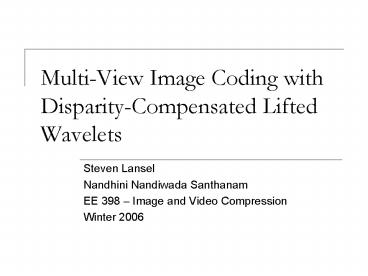MultiView Image Coding with DisparityCompensated Lifted Wavelets PowerPoint PPT Presentation
1 / 15
Title: MultiView Image Coding with DisparityCompensated Lifted Wavelets
1
Multi-View Image Coding with Disparity-Compensated
Lifted Wavelets
- Steven Lansel
- Nandhini Nandiwada Santhanam
- EE 398 Image and Video Compression
- Winter 2006
2
Overview
- Problem Overview
- Disparity Vector Selection
- Transform Explanation
- Pareto-like Condition
- Overall R-D Curve
- Optimal Bit Allocation
- Conclusions
3
Problem Overview
- Images are taken of a scene from multiple angles
- Lifted Haar scheme is used to encode two images
- Transform uses disparity vectors to match similar
blocks in the two images - Optimal allocation of bits between disparity
vectors and L/H images is desired
SPIHT
L
-
P
U
P-1
U-1
-
H
SPIHT
4
Disparity Vector Selection
- For each block in image B, the best block in
image A is found - Disparity vectors for each block are chosen to
minimize JD?DVR where D is the sum of squared
errors and R is the bit rate for the vector - Bit rate for vectors follows Laplacian model
5
Transform Explanation
Input B
Input A
a is percent of connected pixels in A
Output H
6
Transform Explanation (2)
Input B
Input A
For each pixel in L use the pixel in the same
location in A and the first pixel in B that is
mapped to that pixel in A.
Output L
Output H
Not used for unconnected pixels
7
Inverse Transform and Distortion Equations
- Inverse transform equations
- Distortion equations for non-orthonormal
transform
Not used for unconnected pixels
8
Transform Characteristics based on Lambda for DVs
9
Rate-Distortion Curves when Compressing L or H
Image
10
Optimal Bit Allocation using a Given Set of
Disparity Vectors
- Total Distortion
- Cost Function
- Pareto-like Solution
- Total Rate Constraint
11
R-D Dependence on Lambda for DVs
Enlarged region from left plot
12
Overall Rate-Distortion Curve
13
Optimal Bit Allocation
14
Conclusion
- Disparity-compensation matches similar blocks in
the two input images - Resulting transform is not orthonormal
- Disparity vectors must be determined by finding
the best ? for a given total rate - Allocation of bits between L and H images is
achieved by satisfying weighted equation and
total bit rate constraint
15
References
- Aditya Atul Mavlankar, Robust Video
Communication using Motion-Compensated Lifted 3-D
Wavelet Coding, Masters Thesis, Technische
Universität München Lehrstuhl für
Kommunikationsnetze Fachgebiet Medientechnik,
September 2004. - B. Pesquet-Popescu and V. Bottreau,
"Three-Dimensional Lifting Schemes for Motion
Compensated Video Compression," Proceedings of
the IEEE International Conference on Acoustics,
Speech and Signal Processing, Salt Lake City, UT,
May 2001, pp. 1793-1796. - Chuo-Ling Chang, Xiaoqing Zhu, Prashant
Ramanathan, and Bernd Girod, "Inter-view Wavelet
Compression of Light Fields with
Disparity-Compensated Lifting," Proc. SPIE Visual
Communications and Image Processing, VCIP-03,
Lugano, Switzerland, July 2003, pp. 14-22.

